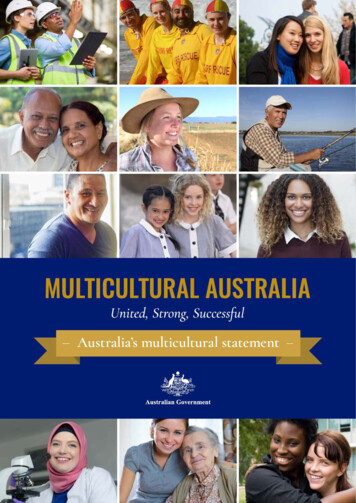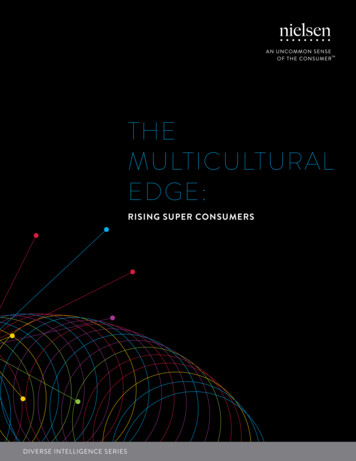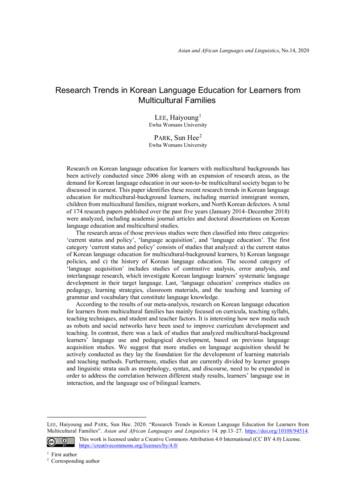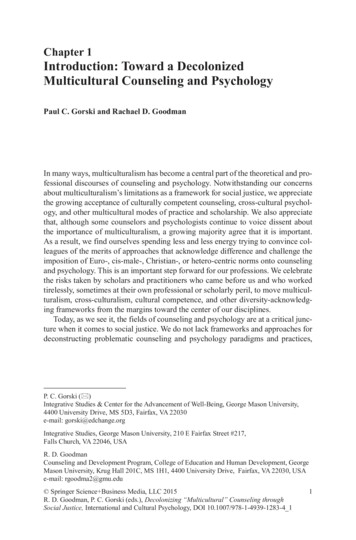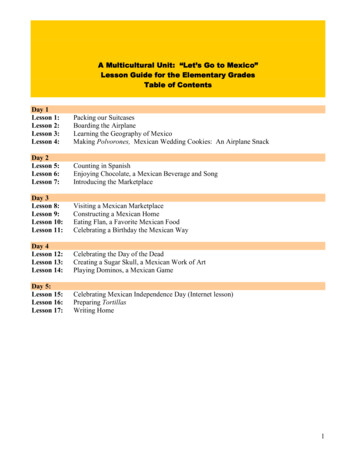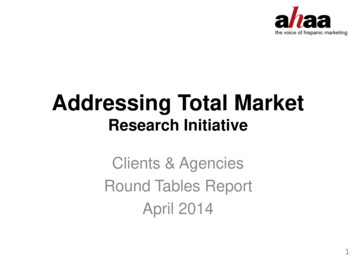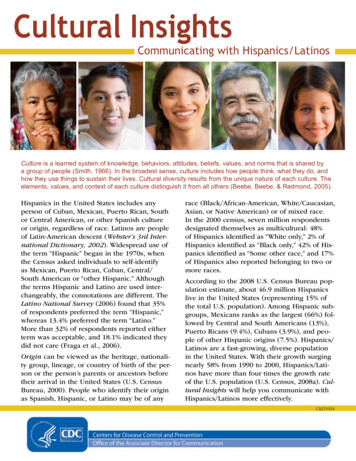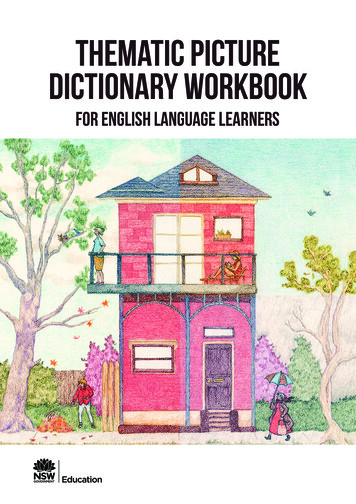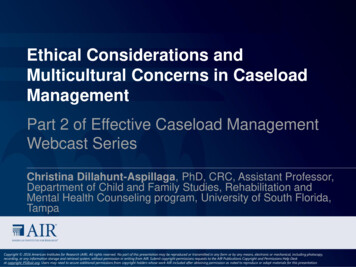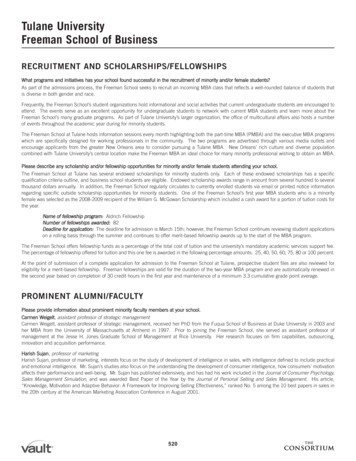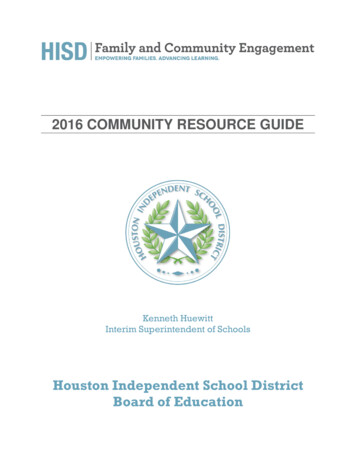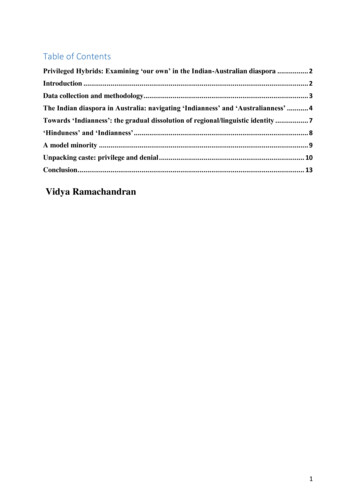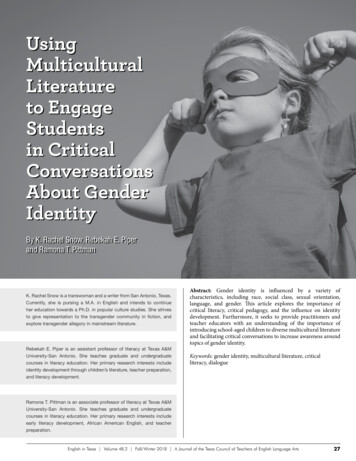
Transcription
UsingMulticulturalLiteratureto EngageStudentsin CriticalConversationsAbout GenderIdentityBy K. Rachel Snow, Rebekah E. Piperand Ramona T. PittmanK. Rachel Snow is a transwoman and a writer from San Antonio, Texas.Currently, she is pursing a M.A. in English and intends to continueher education towards a Ph.D. in popular culture studies. She strivesto give representation to the transgender community in fiction, andexplore transgender allegory in mainstream literature.Rebekah E. Piper is an assistant professor of literacy at Texas A&MUniversity-San Antonio. She teaches graduate and undergraduatecourses in literacy education. Her primary research interests includeidentity development through children’s literature, teacher preparation,and literacy development.Abstract: Gender identity is influenced by a variety ofcharacteristics, including race, social class, sexual orientation,language, and gender. This article explores the importance ofcritical literacy, critical pedagogy, and the influence on identitydevelopment. Furthermore, it seeks to provide practitioners andteacher educators with an understanding of the importance ofintroducing school-aged children to diverse multicultural literatureand facilitating critical conversations to increase awareness aroundtopics of gender identity.Keywords: gender identity, multicultural literature, criticalliteracy, dialogueRamona T. Pittman is an associate professor of literacy at Texas A&MUniversity-San Antonio. She teaches graduate and undergraduatecourses in literacy education. Her primary research interests includeearly literacy development, African American English, and teacherpreparation.English in Texas Volume 48.2 Fall/Winter 2018 A Journal of the Texas Council of Teachers of English Language Arts27
Ms. Ryan is a kindergarten teacher in a suburban part of the southernmost part of the United States. Having been in the classroom for the lastthree years, Ms. Ryan has gained new knowledge about the differentsubjectivities that influence her student’s identity. However, this yearshe has taken a new approach and is listening to the children in herclassroom to better understand their needs as they relate to identitydevelopment. This newfound approach stems from a conversationbetween two children prior to the morning meeting:John: Ms. Ryan, yesterday me and my sister played dress upand I got to wear her princess dress!Melanie: Boys don’t wear dresses (laughter). . . Did you hearthat? John said he wore a dress (encouraging laughter).John: When I am at home, I DO wear dresses and I playwith my sister’s dolls.Melanie: That’s funny. Boys don’t play with dolls.Dolls are for girls.Samantha: Yah, John, dolls are only for girls.John: (upset) It’s NOT funny! I can play dress up and playwith dolls if I want to!Ms. Ryan: Ok, we will talk about this another time, class.Let’s start our morning meeting.Later that afternoon, Ms. Ryan began to question how she approachedthe conversation between the children that morning. She wonderedwhat she should have done differently to help John feel safe in theclassroom. She considered how she could have handled Melanie andSamantha laughing and teasing John. She decided she must take adifferent approach to opening the morning meeting the following day.She knew that there was work to be done.28Conversations like this are common within educationsettings. For teachers, it is vital that they consider thedifferent elements of identity and emphasize the importanceof critical pedagogy and critical literacy with school-aged childrento help them deconstruct messages in text, including conversations,as it relates to gender identity development. One method that isbeneficial is examining the use of children’s literature to introducealternative gender representations. Multicultural literature allowsfor parents and teachers who interact with children to introduce textsto begin dialogue around critical conversations of gender identity.Thinking about this topic more locally, one can consider theconversation during the 2017 Texas legislation which includeddialogue around public schools and bathroom regulations whichwould allow students to use only the bathroom that matchedthat of their biological sex, as noted on their birth certificate.This poses challenges for children who identify as transgenderand can potentially be problematic for children in schools.Schools are able to provide accomodations for children on a caseby case basis, but it can be argued that is not enough. However,providing such accomodations does not truly allow for studentsto express their gender identity in schools. Preparing teachers toapproach these critical conversations with all children can increaseawareness and acceptance.Brief Review of the LiteratureIn an effort to educate school-aged children, it is vital that theyare exposed to a variety of multicultural themed literature. For thepurposes of this work, multicultural literature is defined as literaturethat represents a group of individuals who have been marginalizedor historically underrepresented. Specifically, literature that canbe used as a means to combat homophobia—the irrational fear orhatred of LGBTQ individuals—through the exposure of a varietyof themed children’s literature. Adapted from the work of Freire(1970), Banks (2007), and Nieto (2012), and in an effort to prepareEnglish in Texas Volume 48.2 Fall/Winter 2018 A Journal of the Texas Council of Teachers of English Language Arts
teachers with the tools needed to explore children’s literature, thefollowing four areas can provide a guiding framework for teacher todiscuss gender identity in the classroom:1) identity development,2) multicultural children’s literature, 3) critical pedagogy, and4) critical literacy.Identity DevelopmentMultiple factors exist that influence identity development includingrace, ethnicity, social class, language, gender, sexual orientation,religion, and ability (Nieto & Bode, 2012). Gee (2000) suggests thatidentity is about “being recognized as a certain kind of person in agiven context” (p. 99). As one of the most critical tasks for students,transitioning from childhood into adolescence is the development oftheir identity; thus, it is of paramount importance that educationalexperiences are designed with this in mind (Erikson, 1968).Multicultural Children’s LiteratureMulticultural children’s literature became prominent in the 1970sas a product of the multicultural education movement (Logan,Watson, Hood, & Lasswell, 2016). The multicultural educationmovement sought to allow historically marginalized voices to beheard and featured in school curriculum. Due to the historicalnature of this time period, it was during the 1960s and 1970s thatmost of the multicultural children’s literature was written by Whiteauthors about the lived experiences of African Americans andgenerally promoted negative stereotypes (Logan, Watson, Hood,& Lasswell, 2016). The first picture books that featured a gendernonconforming character was William’s Doll (Zolotow, 1972) andOliver Button Is a Sissy (de Paola, 1979). Ten years later, in 1989,Lesléa Newman published Heather Has Two Mommies and in 1991,Michael Willhoite published Daddy’s Roommate, two books thataddressed same-sex co-parents. Each of these texts aimed to showthat these parents are just like, and just as good as, heterosexualparents and to mirror families with same-sex co-parents (Epstein,2014). Research argues that within the last 15 years, there has beena “dramatic increase” in the number of LGBTQ titles published(Epstein, 2014, p. 113). For example, one study of the ChicagoPublic Library System found that the 30 books in the “juvenilehomosexuality fiction” section were nearly all from the 21st century,during the late 1990s and 2000s (Epstein, 2014). While these textsare becoming more available through publication, it is vital that theauthenticity and implementation are consistent.In classrooms today, it is encouraged that teachers be prepared toapproach critical conversations as students enter classrooms curiousabout civil right issues that are significantly affecting students andfamiles today (Piper, 2017). Worthy, Chamberlain, Peterson, Sharp,& Shih (2012), however, document that educational spaces forstudents to have open-ended conversation around literature arerare in PK-12 schooling. Though multicultural children’s literaturecan facilitate the introduction of diversity topics to classroomconversations, teachers must still facilitate meaningful dialoguearound these topic areas if this literature is to enable them to realizeculturally responsive teaching practices and garner improvementsin all students’ learning outcomes. Engaging children withmulticultural literature fosters critical discussion of broad ranges ofdiverse topics and approaches these topics in age-appropriate ways,thus broadening student perspectives on, and understandings of,society and their important place in it; when this happens, teachershave become culturally responsive educators who can and doaffirm all students.Critical PedagogyAccordingly, multicultural perspectives must become partof both teaching and learning processes, reflected in bothpedagogy and content (Banks, 2007; Delpit, 2012; Nieto, 2010).Defined as critical pedagogy, the practice first gained attentioninternationally with the publication and first English edition ofPaulo Freire’s Pedagogy of the Oppressed in 1970 (McLaren &Kincheloe, 2007). Critical pedagogy promotes understandingof diverse forms of oppression, including class, race, sexualorientation, cultural, religious, and ability-related dimensions ofoppression. This understanding, in turn, provides educationalresearchers with the ability to discern connections to societalpower structures, including education, and human oppression,including that of students in public schools in the United States.Additionally, critical pedagogy promotes an understanding ofhow issues of power and oppression are embodied in everydayhuman life experiences, and, therefore, provides a basis forquestioning various ideologies and related decisions, and thedominance relations they protect (Kincheloe, 2008). Criticalpedagogy is practiced in varying contexts around the world.In education, educator critical consciousness must exist beforecritical pedagogy can be enacted. Gay and Kirkland (2003)explained that teachers who know who they are culturally,understand the sociopolitical contexts in which they teach, andcan recognize and question how their assumptions and priorknowledge may impact the students they teach to possess criticalconsciousness and leverage that consciousness in developingcritical pedagogical practice. When teaching is coupled withcritical self-reflection there is constant transformation andimprovement of self and one’s teaching reality (Gay & Kirkland,2003; Howard, 2006). This task is not simple for teachers. Toooften, classroom teachers focus on the dominant ideologies;which often align to their own interests.Critical LiteracyCritical literacy is related to critical pedagogy and the social justicework of Paulo Freire (2000). Freire’s work brought change to povertystricken areas in Brazil through a movement that empowered poorand otherwise disenfranchised adults to question social structuresthat conditioned them to remain in disempowered spaces. Literacyeducation was the first key factor enabling these adults to beginto face, question, and challenge the status quo (Stevens & Bean,2007). But mere literacy—functional literacy—was not enoughto bring about transformational change. Additionally, Freire andMacedo (1987) argue that literacy education should not onlyprovide basic reading, writing, and numeracy skills, but it mustalso be characterized by “a set of practices that functions to eitherempower or disempower people” (p. 187). They argue that trueliteracy is reflected in the ability to read “the word and the world”(p. 8). From these ideas, the concept of critical literacy formallyemerged. A critical literacy framework encourages teachers toreconsider literacy instruction as “problem posing” education,where the relationships between hegemony, power, and literacy arequestioned, at the same time that literacy skills are being taughtand learned (Freire, 1970). All children benefit educationally fromrich opportunities—especially those that use a critical literacyframework—for gaining knowledge about diverse cultures inthe context of exploring ideas of power and agency that provideopportunities for questioning and acting to reconcile injustices(Fisher & Serns, 1998; Freire, 1970; Stevens & Bean, 2007).English in Texas Volume 48.2 Fall/Winter 2018 A Journal of the Texas Council of Teachers of English Language Arts29
Children’s Literature ThatIntroduces Topics of LGBTQSimilar to the conversation in Ms. Ryan’s classroom, children’scuriosities lead to further questions from their peers. While someteachers may be equipped to facilitate discussion around the topicof gender identity, others may shy away from the topic in fear thattheir own perspective and beliefs will be revealed.Using the four-point framework of identity development—contextof education, multicultural children’s literature, critical pedagogy,and critical literacy—let’s see how Ms. Ryan can use a reflectiveprocess to prepare for her next morning meeting.Ms. Ryan reflects on the conversation that took place earlier in theday. Ahe considers the classroom setting and expectations of heradministration. Feelings of anxiety overcome her thought processas she prepares the lesson for tomorrow’s morning meeting. Was it“appropriate” to share the read aloud story she chose? Would heradministration allow her to have a critical conversation about genderidentity? Could she discuss topics of gender identity in her classroom?Were the kids old enough to have these conversations? In spite ofthe discomfort, Ms. Ryan, refers to the professional standards of theInternational Literacy Assocation (2018). Standard 4 specificallyemphasizes the importance of teachers demonstrating knowledgeof diversity and equity by being knowledgeable about research,theory, pedagogies, and concepts which create classrooms thatare inclusive and affirming for all children. Suddenly, her anxiousfeelings become the inspiration to create a meaningful lesson for herkindergarten students the next day. She has an obligation to teachthese young children.Ms. Ryan begins the morning meeting with a read aloud of Jacob’s NewDress. Using a critical literacy lens, she notes questions throughoutthe read aloud that give opportunity for children to engage indiscussion with one another and the whole group. For example, whatdoes Emily do when Christopher makes fun of Jacob for choosing girlsclothes at the dress up center? Have you ever been bullied because ofa choice you made? Have you ever bullied others because of a choicethey made? When you hear the word “acceptance,” what does it meanto you? As the children answered the questions, Ms. Ryan follows upwith discussion and connection to their own classroom experiences tomake the critical conversation relevant.Because Ms. Ryan understands that identity development is takingplace within the kindergarten classroom, she uses her own backgroundknowledge to discuss multiculturalism and provide examples ofTable 1TitleAuthorGradeLevelsSummaryUsing This TextRead Aloud and DialogueJacob’s NewDressI Am JazzGeorgeLuna30Sarah Hoffmanand Ian HoffmanJessica Hertheland Jazz JenningsAlex GinoJulie Anne PetersPK-2PK-3Jacob enjoys playing with his friend Emily. Heparticularly likes to play dress up because he gets todress like a princess. The other kids in Jacob’s classtease him for wearing dresses because they believeboys can’t wear dresses. Jacob’s teacher helps theother children understand that all children can wearwhat makes them comfortable. Jacob’s teacher andparents are supportive in helping Jacob find his trueidentityBased on the real-life story of a transgender child,this story recounts a young child’s gender transition.From two years old, Jazz Jennings knew that she hada girl’s brain in a boy’s body. She liked the color pink,dancing, makeup, and dress up. Initially, her familywas confused as they had always thought of her as aboy. Then, one day Jazz’s parents took her to a doctorwho said that Jazz was transgender and was born thatway. Jazz’s parents supported her and reminded herthat being different but the same is in fact possible.5-7At school, students look at George and they see a boy.But she knows that she’s not a boy—she’s a girl. Infact, she believes she will have to keep this secret fromeveryone forever. When her teacher announces that theclass play will be Charlotte’s Web, George is certainthat she wants to audition for the role of Charlotte.However, the teacher says she can’t try out for that rolebecause she’s a boy. George and his best friend Kellyset out to design a plan so she can be Charlotte and toshow everyone who she truly is.9-12Narrated by Regan, Liam’s younger sister, this storyintroduces you to the high school senior, Liam. Atnight, Liam transforms into Luna, playing dress upand wearing makeup with Regan. As her protector andonly confidante, Regan does all she can to keep Lunafrom the cruelty of the world around. However, asLuna prepares to emerge it is evident that her familyand friends are showing feelings of anxiety to acceptthe transition.Consider the following questions:What does Emily do when Christopher makes fun ofJacob for choosing girls clothes at the dress up center?Jacob’s mood and expressions change during this story.Why does he start to feel happier towards the end of thestory?What does acceptance mean to you? Have you ever beenbullied by someone like Christopher? Have you ever beenthe bully and teased someone else?Writing ActivityConsider Jazz’s experiences as a student in school. Whatare some ways that you could advocate and help Jazz findher place in the school?As a student in Jazz’s class, write a letter to herexpressing your feelings or thoughts towards her braveryto be herself.Literature CircleUsing the literature circle format, provide differentscenarios from the text that allow opportunities for yourstudents to think critically about how George was feelingbased on her interactions with others in the class.Writing ActivityWrite a letter to Liam from Regan. Identify three mainpoints that you want Liam to know.As Luna, write a letter to your family describing yourfeelings towards this transition. Address the fears andfeelings of anxiety that have overcome you during thistime.English in Texas Volume 48.2 Fall/Winter 2018 A Journal of the Texas Council of Teachers of English Language Arts
differences and acceptance. She prepares artifacts that describe whoshe is, and she allows students to reflect and ask questions in aneffort to learn more about one another. Using a critical pedagogicalapproach with these young children provides opportunity for Ms.Ryan to use life experiences or in this case, classroom experiences tointroduce issues of oppression, a task that many teachers avoid. Ms.Ryan ends the morning meeting with the following statement:Ms. Ryan: Yesterday, friends in our classroom went homewith hurt feelings. I went home with hurt feelings. Today, wetalked about how we are each different and why each of ourfeelings needs to be respected. In our classroom, everyoneis safe to be who he or she is because in this classroom, wecelebrate one another.To promote further the need for diverse literature in classrooms,a selection of texts has been provided for teachers and teachereducators to use to introduce and facilitate critical conversationsaround gender identity. Making these texts available, implementingcritical conversations, and approaching these topics throughusing the four-point framework is just the beginning of preparingteachers and students to create social change.While Table 1 provides a brief summary and examples of activites,Table 2 includes additional texts that can be used as resourcesacross grade levels.Table 2TitleAuthorGrade LevelSparkle BoyLesléa NewmanPK-2Morris Micklewhite and theTangerine DressChristine BaldacchinoPK-1Stella Brings the FamilyMiriam SchifferK-2Introducing Teddy: AGentle Story About Genderand FriendshipJess WaltonPK-1My Princess BoyCheryl KilodavisPK-310,000 DressesMarcus EwertK-4Red: A Crayon’s StoryMichael HallPK-3The Boy in the DressDavid Walliams4-7Annie on My MindNancy Garden7-9The Great AmericanWhateverTim Federle9-12It’s Not Like It’s a SecretMisa Sugiura9-12Adults are influential to a child’s identity development. It isimportant to deconstruct the complex concepts and images thatchildren have regarding identity as it is critical to ensuring theirsuccess in understanding topics of diversity. As the makeup ofclassroom demographics continue to change, it is essential thatteachers are prepared teachers to facilitate critical conversations inmeaningful ways so that when individuals like Ms. Ryan reflect ontheir practice, they are confident in their approach to teach childrenabout diversity and gender differences.ReferencesBanks, J. A. (2007). Educating citizens in a multicultural society (2nd ed.).New York, NY: Teachers College Press.Delpit, L. (2012). Multiplication is for white people. Raising expectations forother people’s children. New York, NY: The New Press.De Paola, T. (2008). Oliver Button is a sissy. Sister Namibia, 20(3), 27-28.Epstein, B. J. (2014). The case of the missing bisexuals: Bisexuality inbooks for young readers. Journal of Bisexuality, 14(1), 110-125.Erikson, E. H. (1968). Identity: Youth and crisis (No. 7). New York, NY:Norton.Fisher, P., & Serns, S. (1998). Multicultural education with pre-serviceteachers: Literature discussion as a window of thought. Paperpresented at the annual meeting of the National ReadingConference, Austin, TX.Freire, P. (1970). Pedagogy of the oppressed. New York, NY: Continuum.ConclusionIdentity is influenced by multiple conditions, including homebased cultural understandings and societal norms. Erikson (1968)noted that a child’s healthy identity development from childhoodto adolescence is vital to his or her academic success and successin society. When teachers introduce a variety of multiculturalliterature, it allows children to consider experiences of others andprovides diverse perspectives to which they can relate. Simplyintroducing this type of literature is not enough, however. Teacherscan increase awareness and build tolerance as they facilitatedialogue and interactions with texts, allowing children to recognizehow society impacts the ways that one’s identity is developed,specifically as it relates to gender.English in Texas Volume 48.2 Fall/Winter 2018 A Journal of the Texas Council of Teachers of English Language Arts31
Freire, P., & Macedo, D. (1987). Literacy: Reading the word and the world.South Hadley, MA: Bergin & Garvey.Gay, G., & Kirkland, K. (2003). Developing cultural critical consciousnessand self-reflection in preservice teacher education. Theory IntoPractice, 42(3), 181-187.Newman, L. (2011). Donovan’s big day. New York, NY. Random HouseDigital.Nieto, S., & Bode, P. (2012). Affirming diversity: The sociopolitical context ofmulticultural education (6th ed.). Boston, MA: Pearson.Gee, J. P. (2000). Identity as an analytic lens for research in education.Review of Research in Education, 25, 99-125.Nieto, S. (2010). Language, culture, and teaching critical perspectives (2ndGino, A. (2015). George. New York, NY: Scholastic.Peters, J. A. (2008). Luna. Boston, MA: Little, Brown.Herthel, J., & Jennings, J. (2014). I am Jazz. New York, NY: Penguin.ed.). New York, NY: Routledge.Piper, R. (2017). Critical conversations. Early Years, 37(3), 10-12.Howard, G. (2006). We can’t teach what we don’t know: White teachers,multiracial schools. New York, NY: Teachers College Press.Stevens, L. P., & Bean, T. W. (2007). Critical literacy: Context, research, andKincheloe, J. L. (2008). Critical pedagogy. New York, NY: Peter LangPublishing.Logan, S. R., Watson, D. C., Hood, Y., & Lasswell, T. A. (2016). Multiculturalinclusion of lesbian and gay literature themes in elementaryclassrooms. Equity & Excellence in Education, 49(3), 380-393.McLaren, P., & Kincheloe, J. L. (2007). Critical pedagogy: Where are wenow? New York, NY: Peter Lang Publishing.32practice in the K-12 classroom. Thousand Oaks, CA: Sage.Yokota, J. (Ed.). (2001). Kaleidoscope: A multicultural booklist for grades K-8(3rd ed.). National Council of Teachers of English (NCTE)bibliography series. Urbana, IL: National Council of Teachers ofEnglish.Zolotow, C. (1972). William’s doll. New York, NY: HarperCollins.English in Texas Volume 48.2 Fall/Winter 2018 A Journal of the Texas Council of Teachers of English Language Arts
Michael Willhoite published Daddy's Roommate, two books that addressed same-sex co-parents. Each of these texts aimed to show that these parents are just like, and just as good as, heterosexual parents and to mirror families with same-sex co-parents (Epstein, 2014). Research argues that within the last 15 years, there has been
